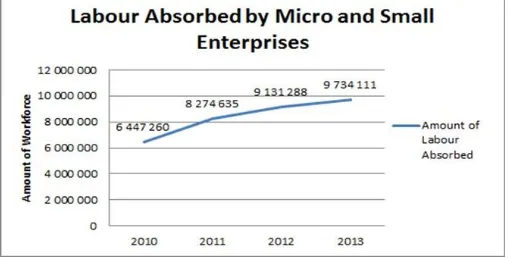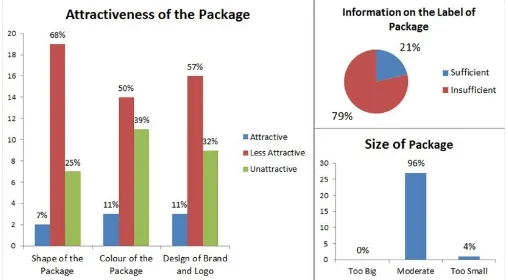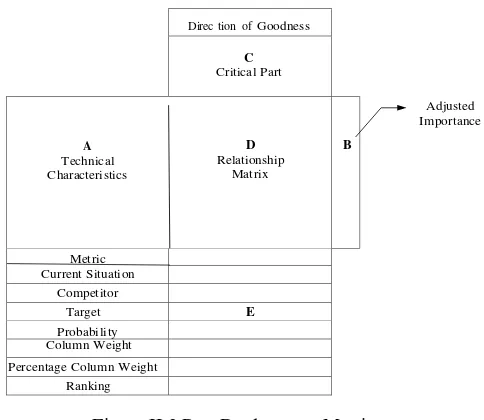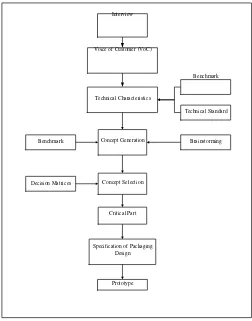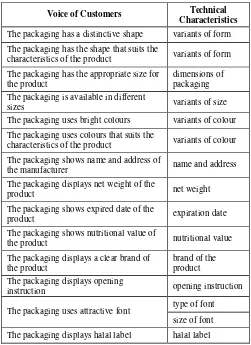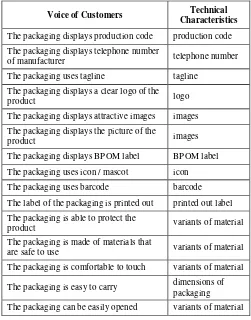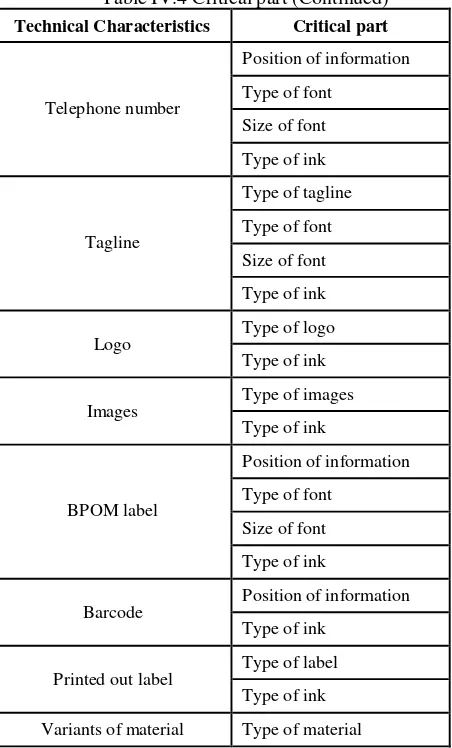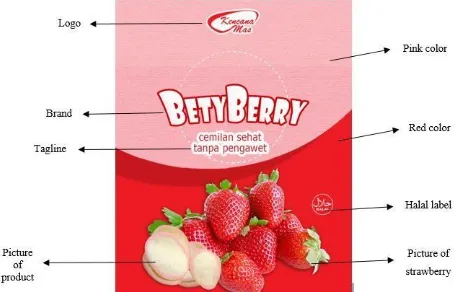Design Improvement of Packaging of
Kerupuk
Strawberry Kencana Mas Using Quality Function
Deployment Method
1
Reza Gilang Pramono,
2Muhammad Iqbal, ST., MM,
3Sari Wulandari, ST., MT,
123
Industrial Engineering Study Program, Industrial Engineering Faculty, Telkom University
Jl. Telekomunikasi No. 1, Terusan Buah Batu, Bandung 40257 Indonesia
1
[email protected],
2[email protected],
3[email protected]
Abstract—UKM Kencana Mas is a Small Medium Enterprise (SME) consist of female farmers and housewives who produce a wide variety of snacks and foods. One of the most popular
product of UKM Kencana Mas is Kerupuk Strawberry, crunchy
cracker made from strawberry. UKM Kencana Mas wants to
expand market and sell Kerupuk Strawberry to supermarkets.
However, the company cannot do it because the packaging of the product has not been standardized yet. Therefore, UKM Kencana Mas should improve the packaging of the product so that it could attract more customer and can be sold at supermarkets.
This research aimed to give recommendation of improved
packaging design of Kerupuk Strawberry using Quality Function
Deployment (QFD) method. The choice of QFD was because it is
a customer-oriented method which will improve customers’
satisfaction. The research was conducted by interviewing customers, collecting Voice of Customers (VoC), spreading
questionnaire, computing Gap, determining technical
characteristics, creating House of Quality (HoQ) matrix, developing concepts, determining critical part, creating part depolyment matrix, and create visual prototype.
The recommendations of packaging design are using combination of pink and red color, shaped standing pouch, using material made from aluminum foil, showing picture of product and strawberry, using BetyBerry brand, using combination mark logo, placing the information on the back side of the packaging, and using font Showcard Gothic for the brand, and Arial for product information.
Keyword— Design, Packaging, Quality Function Deployment, QFD
I. INTRODUCTION
Small and Medium Enterprise (SME) is one of the most important elements in economy sector in Indonesia. This is due to the characteristics of SME which are flexible, operate on small scale, and relatively small investment. Moreover, SME also contributes most to the Growth Domestic Product (GDP) of Indonesia among other business forms. According to the statistics of Kementrian Koperasi dan Usaha Kecil
Menengah (Ministry of Cooperative and Small Medium
Enterprises), SME contributes Rp 3.466.393.30 of total GDP in 2010, and rose to Rp 4.303.571.50 in 2011.
For a developing nations, where the labor is abundant and capital is scarce, the small sector is a major source of employment for millions of people [1]. Indonesia is one of the developing country, and many people work in small and micro enterprises. The Figure I.1 below shows the data from of the workforce absorbed by micro and small enterprise (not including medium scale enterprise) from 2010 to 2013.
Figure I.1 Amount of Workforce in Micro and Small Enterprise from 2010 until 2013 in Indonesia.
(Source: BPS. 2014)
One of the SME in Bandung is Usaha Kecil Menengah
(UKM) Kencana Mas. UKM Kencana Mas are group of female farmers and housewives who produce a wide variety of snacks and foods. UKM Kencana Mas produces unique and innovative snacks made from farm commodities, namely
Kerupuk Strawberry, Stick Strawberry, Kerupuk Nangka,
Abon Jamur, Dodol Labu, Dodol Strawberry, and Kerupuk
Wortel. From the products of UKM Kencana Mas that has
been mentioned above, the researcher chose Kerupuk
Strawberry as research object. According to Mrs. Betty Veronica, the owner of UKM Kencana Mas, Kerupuk
Strawberry is the most popular products and has many people interested in the product.
The packaging of Kerupuk Strawberry has already met some of the requirements, except for the net weight, the address of manufacturers, expiration date and nutritional value of the product.
However, even if the packaging has meet all the standard it is still not enough to get attention from the customers. The
packaging is a core marketing tool for products and it A. Packaging
II. LITERATURE REVIEW
performs the role of communication. It also serves as a silent salesman, which will get customers attention and increase the intention of buying as the customers pass by [2]. Therefore, the packaging is one of the most important marketing tools to attract customers.
The packaging of the Kerupuk Strawberry Kencana Mas is still far from ideal. In order to see how the customers look at the product, a preliminary survey was conducted to 28 people by spreading questionnaire. Those people are students, employees and housewives who often go to the supermarkets and buy food products, male and female with age ranging from 18 to 28. These respondents have the same characteristics with the target customers of Kerupuk
Strawberry Kencana Mas. The result of the survey is shown on the Figure I.2.
Figure I.2 The Result of the Preliminary Survey of the Consumers
of Kerupuk Strawberry Kencana Mas.
From the figure I.1, can be seen that most of the respondents thought that the packaging of Kerupuk Strawberry Kencana Mas is not attractive in every aspects. Only 7 % respondents who thought that the shape of the packaging is appealing and 11% of respondents who thought that color and the design of brand and logo are attractive. The rest of the respondents said that the packaging is less attractive or unattractive at all. Moreover, there are 79% of respondents who said that the information from the label of the packaging is not sufficient enough. However, nearly all respondents agreed that the size of the packaging is already enough as it is.
From the result of the preliminary survey, it can be concluded that the packaging of Kerupuk Strawberry Kencana Mas needs to be improved to attract customers, and to be acceptable for selling in the supermarkets. The method which will be used to solve the problem is Quality Function Deployment (QFD). QFD is chosen because this method based on customer’s needs, by improving the quality of product to fulfill the needs of customers. It will be able to interpret the customers’ needs into engineering directions. Therefore, QFD is the best method for improving the design of the packaging
of Kerupuk Strawberry Kencana Mas.
1) Packaging in Marketing
Packaging is defined as the element of marketing mix whose functions fundamentally hinges on serving the interest of the entire marketing forces through the media of the "manufacturer", "intermediaries" and the "consumer". It includes all the activities of designing and producing the container for a product [3]. Most marketers consider packaging as a key element of product strategy and the fifth P, along with price, product, place and promotion. Packaging is a core marketing tool for products and it performs the role of communication [2].
2) Purpose of Packaging
The basic purposes of packaging are to [4]: 1. Protect and contain.
A packaging must protect its contents from damage during storage, transport and usage.
2. Offer convecience.
The pack must offer convenience in pouring, squeezing, storing, stacking and consuming. and inform user of mandatory requirements.
3) Elements of Packaging
The elements or variables that a designer can use to design a packaging are [3]:
1. Shape.
Shape of the packaging will help to attract customer. A rectangular box created images of sharpness, neatness and cleanliness, while a round box had associations of security, plentifulness and generosity.
2. Size.
Different sizes are aimed at different segments, e.g. the family pack. Pack size can determine target markets. 3. Color.
Color affects perception. The main function of color in a packaging is to attract customer and create image of the product.
4. Text.
Text on the packaging serves as verbal elements include the name, brand, producer/country of origin, information about product, and usage instructions.
5. Graphic.
Graphics on a label can help to create and protect individuality or uniqueness, reinforce a brand name or image, help to reposition, and increase shelf presence. 6. Material.
The material used in packaging affect perceptions of product quality. The same product with different material will have different place in customer’s mind.
Direc tion of Goodness
C
Critical Part
A D
Technical Relationship Characteristics Matrix
B
Metric Current Situation
Competitor
Target E
Probability Column Weight Percentage Column Weight
Ranking
4) Standard of Packaging
The food packaging in Indonesia should include [5]: 1. Name of the product.
2. List of ingredients. 3. Net weight or net volume.
4. The name and address of the manufacturer. 5. Halal label.
6. Expiration date. 7. Nutritional value
B. Quality Function Deployment (QFD)
1) Definition
Quality Function Deployment (QFD) is a methodology to translate customer requirements into the final product of service characteristics. The approach is used for planning products and services, it is a process starting with the voice of the customer [6]. In another definition, QFD is a structured process, a visual language, and a set of inter-linked engineering and management charts which establishes customer value using the voice of the customer and transforms that value to design, production, and manufacturing process characteristics [7].
Based on those definition, QFD is a planning tool used to meet customer desires and needs which will translate the voice of customers into engineering directions. Using QFD, the company can identify and interpret the needs of customers into actionable plan. The output of QFD will help designers and engineers to design better and improved product that will be more acceptable by customer.
2) Steps on QFD
There are 3 main steps of implementing QFD [8]: 1. Collecting Voice of Customer (VoC).
This stage aims to identify customers’ desires and expectations of the company's products. In addition, it also conducted an analysis of competitors' products based on customer perceptions. Data is retrieved by conducting interviews or focus group, followed by questionnaires. 2. Creating House of Quality (HoQ).
The stages of creating house of quality are create matrix of customers’ needs (whats), create planning matrix, determine technical response (hows), determine correlation between technical response and customers’ needs, map the technical response, determine priority and last benchmarking and targeting [9].
3. Analyze and interpret.
Analyze and interpret the results of QFD implementation. The results are expected to help the company improve the quality of the product.
3) House of Quality
The model of HoQ is shown on the Figure II.1 [9].
Figure II.1 House of Quality Matrix (Source: Cohen, 1995)
4) QFD Iteration 2 (Part Deployment)
Designing part deployment matrix is conducted by using the technical response from HoQ as the input, along with the adjusted importance percentage, critical part matrix, relationship matrix, and technical matrix [10]. The model of part deployment matrix is shown on Figure II.2.
Adjusted Importance
Figure II.2 Part Deployment Matrix
(Source: Tan & Pawitra referenced in Setianingsih, 2014)
1. Matrix A: Technical Characteristics
This matrix contains the technical responses which are the output of HoQ. In this matrix these are the main input.
2. Matrix B: Adjusted Importance Percentage This matrix is also derived from the result of HoQ. 3. Matrix C: Critical Part
This matrix shows technical part in relation with the technical response in matrix A. Every critical path is calculated with direction of improvement to improve the quality of the product.
4. Matrix D: Relationship Matrix
This matrix shows how strong the relationship between every technical responses and critical parts.
5. Matrix E: Critical Part Contribution
In this matrix there are several information, which are: a. Metric of each technical response.
b. Target of technical response. c. Probability point. technology, working principles, and form of the product. Good concept generation leaves the team with confidence that the
III. RESEARCH METHODOLOGY
The conceptual model is a framework in which will show the relationship between the variables in the research. Conceptual model in this research can be seen on Figure III.1.
Interview
Voice of Customer (VoC)
Benchmark
full space of alternatives has been explored [11]. Concept generations will be conducted after creating HoQ. The five steps on conducting concept generation are:
1. Clarify the problem.
Clarifying the problem consists of developing a general understanding and then breaking the problem down into sub problems if necessary.
2. Search externally.
External search for ideas can be conducted by interview lead users, consult experts, search patents, search published literature, and benchmark related products. 3. Search internally.
Also known as brainstorming, it is the use of personal and team knowledge and creativity to generate solution concepts.
4. Explore systematically.
Systematic exploration is aimed at navigating the space of possibilities by organizing and synthesizing these
Benchmark
5. Reflect on the solutions and process.
Identify opportunities for improvement in subsequent iterations or future projects.
2) Concept Selection
Concept selection is the process of evaluating concepts with respect to customer needs and other criteria, comparing the relative strengths and weaknesses of the concepts, and selecting one or more concepts for further investigation, testing, or development [11]. The methods of selecting concepts are using external decision, product champion, intuition, multivoting, web-based survey, pros and cons, prototype and test, and the last is decision matrices.
D. Prototype
Prototype is an approximation of the product along one or more dimensions of interest. Under this definition, any entity exhibiting at least one aspect of the product that is of interest to the development team can be viewed as a prototype [11]. In this research, the prototype which will be made is focused- analytical prototype. The analytical prototype will be easier to be made, more flexible to change, and cost less than the physical one. The prototype will only implement the visual aspect of the product, or the “looks-like” prototype.
Figure III.1 Conceptual Model
The research starts from conducting interview and derive the results into VoC. The VoC will be processed into technical characteristics for the design of the packaging. Apart from VoC, the technical characteristics are also derived from benchmark with similar product, and technical standard of packaging.
After the technical characteristics has been defined, then generate the solution concept of the problem using benchmarking and brainstorming. The concept generation is very important to find out the best design of the packaging to improve the marketability of the product. After the concepts have been generated, the next step is conducting concept selection. Concept selection is conducted by using decision matrices tool, including concept screening matrix and concept scoring matrix.
The final step is determining the specific critical part of the product. This step is important to provide information of which part of the product has the most importance for the customers. The output of the research is specification of packaging design and prototype of Kerupuk Strawberry Kencana Mas that is expected to be of help for expanding market share and entering new market channel. The visual design is created by using Photoshop software.
Elements of Packaging
Voice of Customers
Graphic
The packaging displays the picture of the product
The packaging displays BPOM label The packaging uses icon / mascot The packaging uses barcode
The label of the packaging is printed out
Material
The packaging is able to protect the product The packaging is made of materials that are safe to use
Comfort
The packaging is comfortable to touch The packaging is easy to carry The packaging can be easily opened
Elements of Packaging
Voice of Customers
Shape
The packaging has a distinctive shape The packaging has the shape that suits the characteristics of the product
Size
The packaging has the appropriate size for the product
The packaging has variant of product size
Color
The packaging uses bright colors The packaging uses colors that suits the characteristics of the product
Text
The packaging shows name and address of the manufacturer
The packaging displays net weight of the product The packaging shows expired date of the product The packaging displays halal label
The packaging shows nutritional value of the product
The packaging displays a clear brand of the product
The packaging uses attractive font
The packaging displays opening instruction
Graphic
The packaging displays production code The packaging displays telephone number of manufacturer
The packaging uses tagline
The packaging displays a clear logo of the product
The packaging displays attractive images IV. DATA COLLECTING AND PROCESSING
A. Identify Customer Needs
The identification of customer needs are conducted in order to get the attributes of the VoC. The VoC is derived through interview to the customers of Kerupuk Strawberry Kencana Mas. After VoC has been determined, then questionnaire is spread to collect data of customers satisfaction, importance, and level of existing condition. The questionnaires were spread via email and directly given to the respondents. The questionnaire that was spread directly received 46 answers, while the ones that have been sent via email received 8 answers. Therefore, the total of the questionnaire answered was 54 questionnaires.
B. QFD Iteration 1 (HoQ)
1) Voice of Customers
The VoC was derived from interview. The attributes then grouped into elements of packaging. Each of VoC is coded to help data processing easier. The VoC can be seen on Table IV.1.
Table IV.1 Voice of Customers (Continued)
Table IV.1 Voice of Customer
2) Technical Characteristics
The technical characteristics were identified from the VoC. As a result, there were 23 technical characteristics derived. The list of technical characteristics with its correlation with VoC can be seen on Table IV.2.
Table IV.2 Technical Characteristics
Voice of Customers Technical
Characteristics
The packaging has a distinctive shape variants of form The packaging has the shape that suits the
characteristics of the product variants of form The packaging has the appropriate size for
the product
dimensions of packaging The packaging is available in different
sizes variants of size
The packaging uses bright colours variants of colour The packaging uses colours that suits the
characteristics of the product variants of colour The packaging shows name and address of
the manufacturer name and address
The packaging displays net weight of the
product net weight
The packaging shows expired date of the
product expiration date
The packaging shows nutritional value of
the product nutritional value
The packaging displays a clear brand of the product
brand of the product The packaging displays opening
instruction opening instruction
The packaging uses attractive font type of font size of font The packaging displays halal label halal label
Voice of Customers Technical Characteristics
The packaging displays production code production code The packaging displays telephone number
of manufacturer telephone number
The packaging uses tagline tagline The packaging displays a clear logo of the
product logo
The packaging displays attractive images images The packaging displays the picture of the
product images
The packaging displays BPOM label BPOM label The packaging uses icon / mascot icon The packaging uses barcode barcode The label of the packaging is printed out printed out label The packaging is able to protect the
product variants of material
The packaging is made of materials that
are safe to use variants of material
The packaging is comfortable to touch variants of material The packaging is easy to carry dimensions of
packaging The packaging can be easily opened variants of material
Technical Characteristics Critical part
Variants of form Type of form
Dimensions of Packaging Variants of color Type of ink
Net weight
Color Using combination of red and pink Logo Combination marks logo Images Pictures of the product and strawberries
Material Aluminum foil
Tagline Using tagline “Cemilan Sehat
Tanpa Pengawet”
Brand Using Brand “BetyBerry”
Shape Standing pouch
Size Medium
Position of Information
Logo is on the front of packaging, while information is on the back Font Font Showcard Gothic Table IV.2 Technical Characteristics (Continued)
D. QFD Iteration 2 (Part Deployment)
In QFD iteration 2, the researcher needed to determine the critical part. The list of critical part can be seen on Table IV.4.
Table IV.4
C. Concept Development
There were 3 concepts generated. The concepts were generated by benchmarking similar products and brainstorming among development team. After that, conducted concept selection by using concept screening matrix and concept scoring concept. Among 3 concepts, the concept 3 was selected to be developed.
Table IV.3 Concept 3
Technical Characteristics Critical part
Telephone number
Position of information Type of font
Size of font Type of ink
Tagline
Type of tagline Type of font Size of font Type of ink
Logo Type of logo
Type of ink
Images Type of images
Type of ink
BPOM label
Position of information Type of font
Size of font Type of ink
Barcode Position of information Type of ink
Printed out label Type of label Type of ink Variants of material Type of material
Rank Technical Characteristics
1 Variants of material 2 Variants of color 3 Variants of form 4 Dimensions of packaging 5 Images
6 Type of font 7 Size of font 8 Logo
Rank Critical Part
1 Type of ink
2 Position of information 3 Type of font
4 Size of font 5 Height of packaging
Table IV.4 Critical part (Continued) Table V.1 Ranking of Technical Characteristics (Continued)
Rank Technical Characteristics
9 Brand of the product 10 Expiration date 11 Halal label 12 Net weight 13 Tagline 14 BPOM label 15 Telephone number 16 Name and address 17 Printed out label 18 Nutritional value 19 Production code 20 Icon
21 Variants of size 22 Barcode
23 Opening instruction
V. DATA ANALYZING
A. Analysis of QFD Iteration 1
The technical characteristics on HoQ should be ranked to gain knowledge on which technical characteristics that should be developed first. The ranking of technical characteristics can be seen on Table V.1.
Table V.1 Ranking of Technical Characteristics
B. Analysis of Concept Development
The idea generation was done by search externally and internally. The external method used was benchmarking, whereas the internal method used was brainstorming. After searching ideas externally and internally, the next step is using morphological chart. The concepts generated from morphological chart was 3 alternatives. The concept chose to develop is concept 3, because it has the largest net score among all by using concept screening matrix and concept scoring matrix. The selection criteria used for scoring the concept were ease of manufacturing, portability, comfort, resistance for external factor, ease of storage, aesthetic aspect, and product information.
C. Analysis of QFD Iteration 2
The critical part is the important part to make sure how the technical characteristics can be achieved. After critical part has been determined, than using part deployment matrix can be seen which part that should be prioritized. The ranking of critical part can be seen on Table V.2.
Table V.2 Ranking of Critical Part
Table V.2 Ranking of Critical Part (Continued)
Rank Critical Part
6 Width of packaging 7 Length of packaging 8 Type of form 9 Type of images 10 Type of logo 11 Type of brand 12 Type of tagline 13 Type of label 14 Type of material
D. Packaging Design Recommendation
Packaging design recommendation is determined on the result of concept development.
1) Recommendation for Color Design
Color used for the packaging design is combination of red and pink, based on VoC that the packaging uses bright colors, and the packaging uses colors that suits the characteristics of the product. Red and pink color are used on the packaging because they describe the characteristics of strawberry and often associated with strawberry food products.
2) Recommendation for Shape Design
The shape design for packaging is standing pouch, because it fulfills the requirement of the packaging has a distinctive shape and the packaging has the shape that suits the characteristics of the product. A standing pouch is rather unique, compared to the shape of normal pouch. It also fits the characteristics of a product, since standing pouch is used for product shaped like chips.
3) Recommendation for Material
Selection for material has to be done carefully, because not only important for the product but also material can give perception for the quality of the product. The material chosen for the packaging is aluminum foil. Aluminum foil has often used for food packaging, because it is safe for the food itself, and is able to protect the content.
4) Recommendation for Design Images
Images will help to attract the customer, and also communicating the product to the customers. The recommendation images for the packaging are picture of
kerupuk and strawberries. The product itself is a kerupuk, an
Indonesian chip made from strawberries. Thus, the researcher has decided to use picture of kerupuk and strawberry on the packaging.
5) Recommendation for Brand
The brand that is chosen for the packaging is BetyBerry. The old brand, “Kerupuk Strawberry” is considered too common, and does not have any differentiation to other products. The
selection of BetyBerry brand is derived from brainstorming of development team and also involves customers.
6) Recommendation for Logo and Tagline
Logo chosen for the packaging is the combination mark, which has both symbol and text in it. The symbol depicts simplicity, showing that the company will keep it simple but attractive. The text “Kencana Mas” is made to help customers to know and distinguish the product. For the tagline, the one chosen by researcher is Cemilan Sehat Tanpa Bahan
Pengawet.
7) Recommendation for Label Position
The recommendation for label position is the brand, logo, tagline and images are on the front side of the packaging, while other information products are on the back side of the packaging. The brand, logo, tagline and images are placed on the front side to help customers spot the product and immediately attract them. The product information are placed on the back side, so that the front side is not too full with text and images and people will be able to read the information clearly.
8) Recommendation for Font Design
Recommendation for font design is using font Showcard Gothic for the brand, and Arial for the information. Showcard Gothic is unique, attractive, while also easy to read. This font also common in use of food packaging, therefore this font is suitable for the packaging. Font Arial is easy to read, and therefore is the most suitable for the packaging information.
E. Visual Prototype
Visual prototype was made by using Adobe Photoshop software. The design of packaging was based on the concept selected. The picture of front cover is shown on Figure V.1, while the picture of back cover is shown on Figure V.2. The picture of front view of packaging is shown on Figure V.3, while the picture of back view is shown on Figure V.4.
Figure V.1 Front Cover of Packaging Design
Figure V.2 Back Cover of Packaging Design
Figure V.3 Front View of Packaging
Figure V.4 Back View of Packaging
VI. CONCLUSION
A. Conclusion
Based on the objectives of this research, it can be concluded that:
1. On QFD Iteration 1, there are 23 technical characteristics that will be prioritized for development, which are variants of form, dimensions of packaging, variants of size, variants of color, name and address, net weight, expiration date, nutritional value, brand of the product, opening instruction, type of font, size of font, halal label, production code, telephone number, tagline, logo, images, BPOM label, icon, barcode, printed out label, and variants of material.
2. On QFD Iteration 2, there are 14 critical part derived that will be prioritized for development, which are type of form, height of packaging, width of packaging, length of packaging, type of ink, position of information, type of font, size of font, type of brand, type of tagline, type of logo, type of images, type of label, and type of material. 3. The improvement of the design of the packaging of
Kerupuk Strawberry Kencana Mas is derived from the
result of benchmarking and consideration of the company’s capability to fulfill it. The recommendation are as follow:
a. Color used for the packaging design is combination of red and pink.
b. The shape design for packaging is standing pouch. c. The material chosen for the packaging is aluminum
foil.
d. The recommendation images for the packaging are picture of kerupuk and strawberries.
e. The brand for the packaging is BetyBerry. f. Logo for the packaging is the combination mark. g. The recommendation for label position is the brand,
logo, tagline and images are on the front side of the packaging, while other information products are on the back side of the packaging.
h. Recommendation for font design is using font Showcard Gothic for the brand, and Arial for the information.
B. Suggestion
1. For UKM Kencana Mas.
a. UKM Kencana Mas is expected to apply the packaging design that has been recommended in order to achieve goals which are to expand the market and sell their product to supermarkets.
2. For further research.
a. The researcher should understand the concept of characteristics and critical part for interpreting the needs to generate improved design.
b. The researcher should be able to use software for designing, since it will help to create the visual prototype of the packaging.
future, the research is conducted by several researcher. While one will explore on marketing and design aspect, the other will explore the manufacturing aspect of the design.
REFERENCES
[1] Venkatesh, S., & Muthiah, K. (2012). SME in India: Importance and Contribution. ASIAN JOURNAL OF MANAGEMENT RESEARCH, VOL 2 ISSUE 2, 792-796.
[2] Butkeviciene, V., Stravinskiene, J., & Rutelione, A. (2008). Impact of consumer package communication on consumer decision making process. Inzinerine Ekonomika-Engineering Economics (1), 57-65. [3] Kotler, P., & Keller, K. (2012). Marketing Management 14th edition.
Upper Saddle River, N.J.: Pearson.
[4] Smith, P., & Taylor, J. (2009). Marketing communication: an integrated approach (4th edition). London: Kogan Page.
[5] UU RI No.7 Tahun 1996 about food
[6] Ictenbas, B. D., & Eyrilmaz, H. (2011). Quality Function Deployment as A Strategic Planning Tool. International Journal of Social Sciences and Humanity Studies, Vol 3, No.2, 73-82.
[7] Shahin, A. (2008). Quality Function Deployment: A Comprehensive Review. Total Quality Management-Contemporary Perspectives and Cases, 47-79.
[8] Erfando, T. (2011). Perancangan Desain Kemasan Transportasi Buah Salak untuk Kebutuhan Ekspor dengan Metode Quality Function Deployment. Depok.
[9] Cohen, L. (1995). Quality Function Deployment - How to make QFD work for you. Addison Wesley Longman Inc.
[10] Day, R. G. (1993). Quality Function Deployment, Linking a Company with Its Customers. Wisconsin: ASQC Quality Press..
[11] Ulrich, K. T., & Eppinger, S. D. (2012). Product Design and Development. New York: The McGraw-Hill Companies, Inc.
